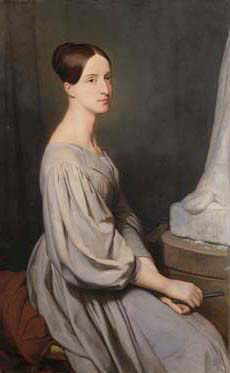| | | | | | | |
| | | Johann
Karl Friedrich Gauss | | | (Carl
Friedrich Gauß) | | | | | | Braunschweig
30.April.1777- Göttingen,
Hanover 23.February.1855 | | | | |
|
|
|
| Signes
biographiques |
|
| | | | | |
|
|
|
| It is born in a family of laborers, the mother
daughter of peasants and second moglie of the father who was
to giardiniere. In
the 1792 it was enrolled to the Collegium Carolinum,
that
then it would have become Gauss in the 1803 Techinische Hochschule di
Braunschweig. The professor and. To W. Zimmerman made so that Gauss
obtained one pension from duca the
Carl Wilhelm Ferdinand that said the possibility to Gauss to continue
the studies until to the university. In the 1795 Gauss it
began
the university studies to the faculty of Göttingen.
30 March 1796 succeeded to construct to a regular polygon of 17 sides
with line and calipers. In
this decided occasion he definitively for the
mathematics studies, in spite of its alive interest for the ancient
languages. In 1799 it
obtained the doctorate to the university of Helmstedt, with one
extraordinary containing dissertation the first exact
demonstration of
the fundamental theorem of algebra. |
|
|  1801 mark two extraordinary events, the
publication of " Disquisitiones arithmetucae" and
the calculation of the orbit of the asteroid Cerere (Ceres) observed
from, G. Public squares in January of the same
year. 9 October 1805 Gauss married Johanna Osthoff, of Braunschweig
from which it had one son and one daughter .
Their happy union however was interrupted in 1809 from birth
of the third son who caused the dead women of the
mother.
In 1806, to the dead women of the duca of Braunschweig, in spite of its
natural aversion for the instruction, it accepted the assignment of
director of the astronomical Observatory and
ordinary of
astronomy to the university of Göttingen, that it maintained
until
death. Risposa in 1810 with the best friend of
the moglie Minna Waldeck from this new union a male and one will be
born themselves female (Teresa). In 1816 he was person in charge to
carry out the geodetic measurements of the reign of Hannover, of which
it made Göttingen part.
In this occasion he invented the eliotropo, an optical telegraph; he
developed geometry he differentiates them and he
constructed a theory for the elimination of the
errors in the calculation. The measurement lasted in all venticinque
years. In 1821 to Berlin, in occasion of a conference of the
scientists and the German doctors, Gauss knew the still young W
physicist. And Weber
that Gauss made to call to Göttingen. Between the two one was
settled down exceptionally fecund collaboration in
the study of the electromagnetic phenomena and the land
magnetism. 1801 mark two extraordinary events, the
publication of " Disquisitiones arithmetucae" and
the calculation of the orbit of the asteroid Cerere (Ceres) observed
from, G. Public squares in January of the same
year. 9 October 1805 Gauss married Johanna Osthoff, of Braunschweig
from which it had one son and one daughter .
Their happy union however was interrupted in 1809 from birth
of the third son who caused the dead women of the
mother.
In 1806, to the dead women of the duca of Braunschweig, in spite of its
natural aversion for the instruction, it accepted the assignment of
director of the astronomical Observatory and
ordinary of
astronomy to the university of Göttingen, that it maintained
until
death. Risposa in 1810 with the best friend of
the moglie Minna Waldeck from this new union a male and one will be
born themselves female (Teresa). In 1816 he was person in charge to
carry out the geodetic measurements of the reign of Hannover, of which
it made Göttingen part.
In this occasion he invented the eliotropo, an optical telegraph; he
developed geometry he differentiates them and he
constructed a theory for the elimination of the
errors in the calculation. The measurement lasted in all venticinque
years. In 1821 to Berlin, in occasion of a conference of the
scientists and the German doctors, Gauss knew the still young W
physicist. And Weber
that Gauss made to call to Göttingen. Between the two one was
settled down exceptionally fecund collaboration in
the study of the electromagnetic phenomena and the land
magnetism.
1831
die the
second moglie Minna Waldeck. The daughter Teresa will take the redini
of the domestic life. In
1833 they they constructed a first electromagnetic telegraph, that it
connected the observatory to the Institute of physics of
Göttingen. From their collaboration the system of physical
measures absolute (known like c.g.s gushed today.
electrostatic and c.g.s. electromagnetic) that Gauss proposed
to the public in 1832. |
|
| After
the 1850 Gauss accusation it disturbs to the heart, disease that will
limit on the scientific engagements.
It dies in the sleep in February 1855.In
1855 it the acknowledgment "Princeps was conferredmathematicorum".
Its works are exited in twelve volumes to Göttingen
between 1863 and 1933. |
|
|
|
|
| Gauss is the c.g.s. unit
(symbol Gs) of magnetic induction or magnetic flux density, replaced by
the unit, the tesla, but still commonly used. It is equal to one linens
of magnetic flux for square centimetre. The Earth' s magnetic field is
about 0,5 Gs, and changes to it over Time to are measured in gammas
(one range equals 10-5 gauss). |
|
| |
|
|

